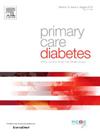Trends in type 2 diabetes medication use and guideline adherence in Belgian primary care (2019–2023)
IF 2.6
4区 医学
Q3 ENDOCRINOLOGY & METABOLISM
引用次数: 0
Abstract
Aims
To assess the prevalence of atherosclerotic cardiovascular disease (ASCVD), heart failure (HF), and chronic kidney disease (CKD) among patients with type 2 diabetes (T2D) in Belgium. To analyze trends in medication use and adherence to guidelines from 2019 to 2023.
Methods
We conducted a retrospective cross-sectional analysis using data from the Intego primary care database, encompassing records from 431 general practitioners. We identified adults with T2D through diagnostic codes and glycated hemoglobin levels and analyzed subgroups with ASCVD, HF, and CKD for trends in medication use, particularly SGLT2 inhibitors (SGLT2-i) and GLP-1 receptor agonists (GLP-1).
Results
The T2D population increased from 20,766 in 2019 to 21,764 in 2023. The prevalence of ASCVD, HF, and CKD among T2D patients slightly increased to 27 %, 6.7 %, and 23.7 % by 2023 (from 25.2 %, 4.9 % and 21.5 % respectively). Medication prescription trends showed a tripling of SGLT2-i and GLP-1 prescribing in the study period to 6.2 % and 11.5 % respectively. Despite these increases, only 7.5 % of eligible patients received these medications as of 2023.
Conclusion
The study highlights a growing burden of ASCVD, HF, and CKD among T2D patients in Belgium and an increase in the use of guideline-recommended medications. However, there remains a substantial gap in the optimal use of these therapies, indicating a need for improved implementation of clinical guidelines in primary care.
比利时基层医疗机构 2 型糖尿病用药趋势和指南遵守情况(2019-2023 年)。
目的:评估比利时2型糖尿病(T2D)患者中动脉粥样硬化性心血管疾病(ASCVD)、心力衰竭(HF)和慢性肾脏疾病(CKD)的患病率。分析2019年至2023年的用药趋势和指南遵守情况:我们使用 Intego 初级医疗数据库中的数据进行了一项回顾性横断面分析,该数据库包含来自 431 名全科医生的记录。我们通过诊断代码和糖化血红蛋白水平确定了患有 T2D 的成年人,并分析了患有 ASCVD、HF 和 CKD 的亚组的用药趋势,尤其是 SGLT2 抑制剂(SGLT2-i)和 GLP-1 受体激动剂(GLP-1):T2D人群从2019年的20766人增加到2023年的21764人。到 2023 年,T2D 患者中的 ASCVD、HF 和 CKD 患病率分别从 25.2%、4.9% 和 21.5%略增至 27%、6.7% 和 23.7%。药物处方趋势显示,在研究期间,SGLT2-i 和 GLP-1 的处方量分别增加了两倍,达到 6.2% 和 11.5%。尽管如此,截至 2023 年,只有 7.5% 的合格患者接受了这些药物治疗:这项研究表明,比利时 T2D 患者的 ASCVD、HF 和 CKD 负担日益加重,指南推荐药物的使用也在增加。然而,在这些疗法的最佳使用方面仍存在巨大差距,这表明需要在初级保健中更好地实施临床指南。
本文章由计算机程序翻译,如有差异,请以英文原文为准。
求助全文
约1分钟内获得全文
求助全文
来源期刊

Primary Care Diabetes
ENDOCRINOLOGY & METABOLISM-PRIMARY HEALTH CARE
CiteScore
5.00
自引率
3.40%
发文量
134
审稿时长
47 days
期刊介绍:
The journal publishes original research articles and high quality reviews in the fields of clinical care, diabetes education, nutrition, health services, psychosocial research and epidemiology and other areas as far as is relevant for diabetology in a primary-care setting. The purpose of the journal is to encourage interdisciplinary research and discussion between all those who are involved in primary diabetes care on an international level. The Journal also publishes news and articles concerning the policies and activities of Primary Care Diabetes Europe and reflects the society''s aim of improving the care for people with diabetes mellitus within the primary-care setting.
 求助内容:
求助内容: 应助结果提醒方式:
应助结果提醒方式:


